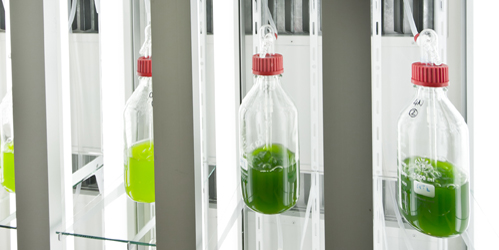The world’s oceans teem with unicellular algae that carry out photosynthesis in the sunlight. It has been known for a while that the particularly abundant diatoms (unicellular algae with a silicate frustule) are also able to survive in the dark bottom of the ocean, where neither photosynthesis nor respiration with oxygen is possible. Scientists of the Max Planck Institute for Marine Microbiology now disclose this artifice of the algae in the journal Proceedings of the National Academy of Sciences: In darkness, the diatoms breathe with nitrate in place of oxygen.
Microalgae often measure only a few hundredths of a millimeter, but due to their vast abundance in the world’s oceans they are responsible for about 40% of the marine primary production, i.e., the biomass production via carbon dioxide fixation in the sunlight. They often appear as massive blooms near the sea surface or as greenish-brownish meadows on the sea floor, if still reached by sunlight. However, diatoms (unicellular algae with a silicate frustule) are also able to survive in the absence of sunlight and oxygen, for instance, buried in the sea floor. Anja Kamp, Dirk de Beer, Jana L. Nitsch, Gaute Lavik, and Peter Stief, scientists at the Max Planck Institute for Marine Microbiology in Bremen cultivated several diatom species in the laboratory to explore the metabolic process that allows the tiny algae to survive in darkness. A correlation was found between the nitrate that is stored by a diatom cell and its ability to survive in the absence of sunlight and oxygen. The more nitrate the cell contained, the longer it could survive in darkness where the cell does not have the possibility to produce oxygen via photosynthesis for its own respiration. In experiments with the coffee-bean-shaped diatom Amphora coffeaeformis, the scientists proved that diatoms use the nitrate stored in their cells for respiration in the absence of oxygen. Within just one day, most of the stored nitrate is used up, converted to ammonium, and excreted by the cell. A key finding of the Max-Planck scientists was that diatoms use nitrate just for respiration rather than for biomass production, as would be the case in sunlight. Anja Kamp says: “The rapid consumption of nitrate and the absence of biomass production tell us that nitrate respiration in diatoms is a metabolic process that only serves to prepare the cell for a resting stage and therefore nitrate respiration is not sustained for longer time periods.”
In bacteria, nitrate respiration in the absence of oxygen is nothing exceptional, as many of the bacteria studied at the Max-Planck-Institute are able to breathe with nitrate, sulfate, or even iron compounds. It is more spectacular to discover that algae, i.e., organisms with a cell nucleus, are able carry out both photosynthesis and nitrate respiration, each under different environmental conditions. These results have just been published in the renowned interdisciplinary journal Proceedings of the National Academy of Sciences.Further inquiries to:
Dr. Anja Kamp; Phone: +49 421 2028 856; akamp@mpi-bremen.de
or to the press officer:
Dr. Manfred Schlösser; Phone: +49 421 2028 704; mschloes@mpi-bremen.de
Download: http://www.pnas.org/content/early/2011/03/09/1015744108.full.pdf+html
Original article:
Diatoms respire nitrate to survive dark and anoxic conditions. Anja Kamp, Dirk de Beer, Jana L. Nitsch, Gaute Lavik, and Peter Stief. Proceedings of the National Academy of Sciences of the United States of America. doi:10.1073/pnas.1015744108

